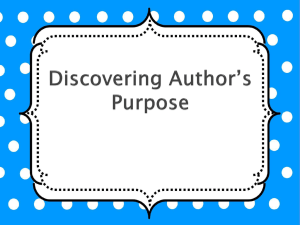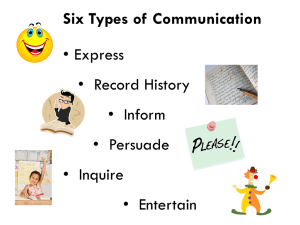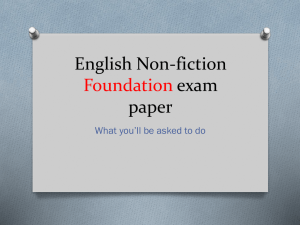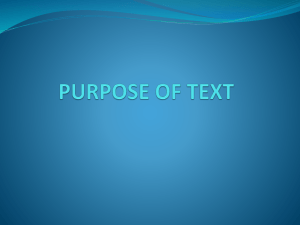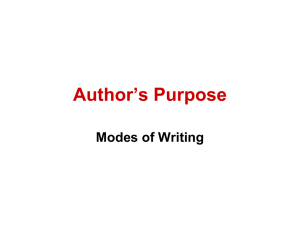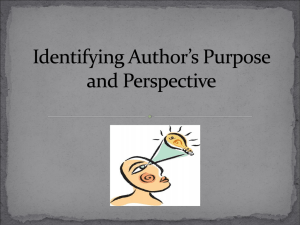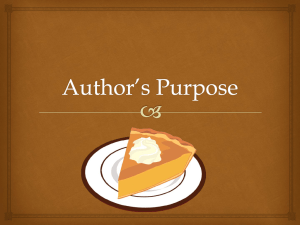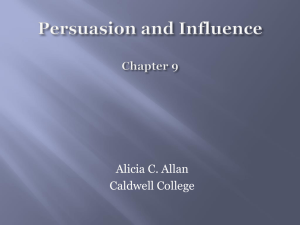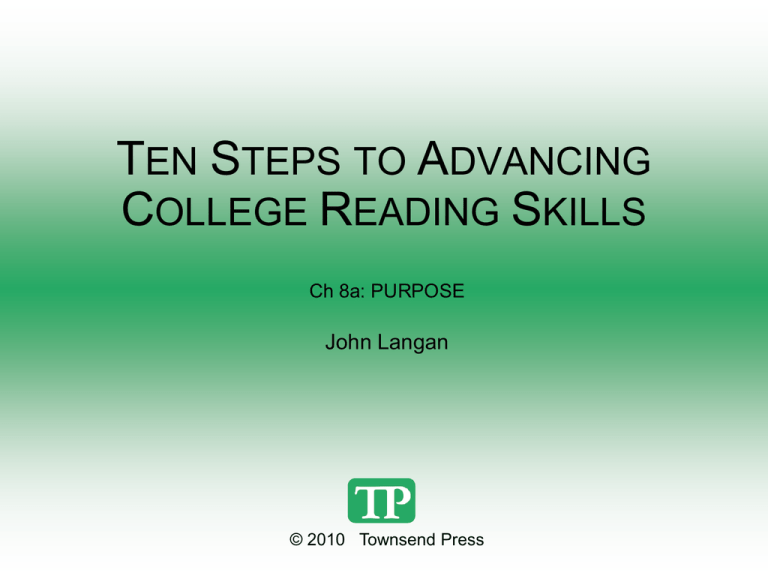
TEN STEPS TO ADVANCING
COLLEGE READING SKILLS
Ch 8a: PURPOSE
John Langan
© 2010 Townsend Press
Chapter Eight:
Purpose and Tone
There is an author—a person with thoughts, feelings,
and opinions—behind everything you read.
Authors write from a personal point of view.
That point of view is reflected in
• the purpose of a piece of writing—to inform, to
persuade, or to entertain—and
• its tone — the expression of attitude and feeling.
PURPOSE AND TONE
The purpose of this cartoon, like all cartoons, is to
entertain.
Can you tell what the tone of each speaker is? Which
one actually means what he or she is saying? Which
one does not?
REAL LIFE ADVENTURES © 2008 GarLanco, Reprinted with permission of UNIVERSAL PRESS SYNDICATE. All rights reserved.
PURPOSE AND TONE
The man means what he is saying. He is asking the woman to
go on an errand with him, so we can assume he enjoys and
desires her company.
The woman does not mean what she is saying. Few people
would consider a trip to drugstore a “fun date,” so we can infer
she is being sarcastic, saying the opposite of what she means.
REAL LIFE ADVENTURES © 2008 GarLanco, Reprinted with permission of UNIVERSAL PRESS SYNDICATE. All rights reserved.
PURPOSE
Three common purposes (reasons for writing) are:
• To inform — to give information about a subject.
• To persuade — to convince the reader to agree
with the author’s point of view on a subject.
• To entertain — to amuse and delight; to appeal
to the reader’s senses and imagination.
PURPOSE
The cover and title of anything you read often suggest the
author’s primary purpose. What do you think is the main
purpose of each of these books?
Primary purpose:
A. to inform
B. to persuade
C. to entertain
Primary purpose:
A. to inform
B. to persuade
C. to entertain
Primary purpose:
A. to inform
B. to persuade
C. to entertain
PURPOSE
The cover and title of anything you read often suggest the
author’s primary purpose. What do you think is the main
purpose of each of these books?
Primary purpose:
A. to inform
B. to persuade
C. to entertain
Primary purpose:
A. to inform
B. to persuade
C. to entertain
Primary purpose:
A. to inform
B. to persuade
C. to entertain
PURPOSE
Read the paragraph below and decide what the author’s purpose is.
Athletes should not earn millions of dollars a year. If they weren’t
paid so much, then tickets to sports events wouldn’t have to be so
expensive, and more people could enjoy sports more often. Also, more
reasonable pay would make for better role models for young people,
many of whom look up to sports figures.
Primary purpose:
A. to inform
B. to persuade
C. to entertain
PURPOSE
Athletes should not earn millions of dollars a year. If they weren’t
paid so much, then tickets to sports events wouldn’t have to be so
expensive, and more people could enjoy sports more often. Also, more
reasonable pay would make for better role models for young people,
many of whom look up to sports figures.
Primary purpose:
A. to inform
B. to persuade
C. to entertain
The author wants to persuade us that “athletes should not earn millions
of dollars every year.” The word should is a clue. Words like should, ought,
and must are often used to persuade.
PURPOSE
Read the paragraph below and decide what the author’s purpose is.
The Bubonic plague, also called the Black Death, swept Europe,
Asia, and Africa from 1346 to 1353. So deadly was this disease that it
killed one-third of the population of these continents. The plague was
spread by fleas infected with bacteria from diseased rats. When it resulted
in pneumonia, coughing spread the bacteria directly through the air.
Primary purpose:
A. to inform
B. to persuade
C. to entertain
PURPOSE
The Bubonic plague, also called the Black Death, swept Europe,
Asia, and Africa from 1346 to 1353. So deadly was this disease that it
killed one-third of the population of these continents. The plague was
spread by fleas infected with bacteria from diseased rats. When it resulted
in pneumonia, coughing spread the bacteria directly through the air.
Primary purpose:
A. to inform
B. to persuade
C. to entertain
The author is providing us with factual details about the Black
Death.
PURPOSE
Read the paragraph below and decide what the author’s purpose is.
Men don’t even notice 97 percent of the beauty efforts women
make. For example, the average woman spends five thousand hours per
year worrying about her fingernails. But I have never once, in more than
forty years of listening to men talk about women, heard a man say, “She
has a nice set of fingernails!” Many men would not notice if a woman
had upward of four hands.
Primary purpose:
A. to inform
B. to persuade
C. to entertain
PURPOSE
Men don’t even notice 97 percent of the beauty efforts women
make. For example, the average woman spends five thousand hours per
year worrying about her fingernails. But I have never once, in more than
forty years of listening to men talk about women, heard a man say, “She
has a nice set of fingernails!” Many men would not notice if a woman
had upward of four hands.
Primary purpose:
A. to inform
B. to persuade
C. to entertain
In order to entertain us, the author uses playful and exaggerated
details about women’s efforts to look beautiful.
WRITING WITH MORE THAN ONE PURPOSE
At times writing may blend two or even three purposes.
The main purpose of your textbook for this course is to inform.
WRITING WITH MORE THAN ONE PURPOSE
At times writing may blend two or even three purposes.
The main purpose of your textbook for this course is to inform.
But the purpose of “Some Quick Study Tips” on pages 9 and 10 is
to inform and to persuade.
WRITING WITH MORE THAN ONE PURPOSE
At times writing may blend two or even three purposes.
“The explanation is that
you’ve been eating too much
pepperoni pizza, Mr. Jones.”
The main purpose of your textbook for this course is to inform.
But the purpose of “Some Quick Study Tips” on pages 9 and 10 is
to inform and to persuade. And the purpose of the cartoons in the
book is to inform and to entertain.

